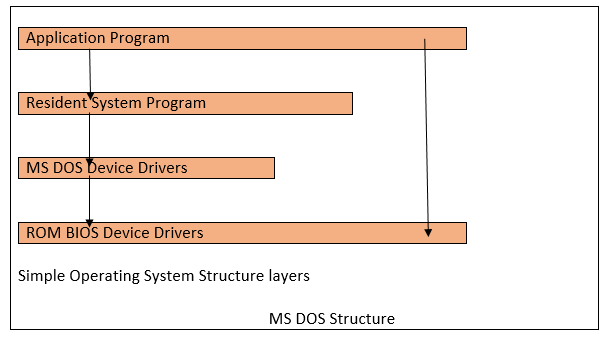Simple Structure in Operating Systems (OS)Abbreviations
IntroductionWe know that the Operating System is very important for working of the Computer. Let us know a bit about the Operating System once. The operating system (OS) is a piece of software program or application that serves as a user interface for computer hardware. To execute other applications, every computer system needs at least one operating system. Applications such as browsers, MS Office, Notepad games, etc. require an environment in order to execute and carry out their functions. Without learning computer language, the OS enables you to communicate with the computer. Without an operating system, a user is unable to operate any computer or mobile device. The operating system (OS) gives the user a channel through which to interact with the computer hardware. The operating system is followed by the installation of system software. The fundamental concept required to construct operating systems is the operating system structure. There are several different sorts of structures, each with a set of outlined characteristics. We will slowly know about them now. Operating System StructureBecause an operating system has a complicated structure, we want a well defined framework to help us apply it to our particular needs. A simpler way to construct an operating system is in sections, much as we split down a large problem into smaller, simpler sub problems. Additionally, each division is a part of the operating system. An operating system structure is the method of linking and incorporating various operating system components into the kernel. Operating systems are implemented using a variety of structures, as will be stated further down. There are four types of different Operating System Structures. They are:
As our topic name is Simple Structure of Operating System. Let us know about Simple Operating System Structure. Simple Operating System StructureSimple Operating System Structure Layered Diagram
It is also known as the simplest Operating System Structure in the history of Operating Systems. It is generally used for a single computer or for a small group of computers. Since the interfaces and functional levels are clearly separated in this structure, programs are able to access Input and Output routines, which may result in illegal access to Input and Output routines. MS DOS (Microsoft Disk Operating Systems) is the best example for Simple Structure in Operating Systems. The MS DOS operating system benefits from layering since each level may be developed individually and can interact with other levels as needed. When a user program fails, the operating system as a whole crashes. Because MS DOS systems have a low degree of abstraction, applications and I/O procedures are accessible to end users, giving them the potential for unwanted access. If the system is built in layers, it will be simpler to design, manage, and upgrade. Because of this, simple structure may be used to build constrained systems that are less complicated. There are four layers in the Simple Operating System Structure. They are:
Advantages
Disadvantages
Next TopicWhat is the Process in Operating Systems
|
 For Videos Join Our Youtube Channel: Join Now
For Videos Join Our Youtube Channel: Join Now
Feedback
- Send your Feedback to [email protected]
Help Others, Please Share










